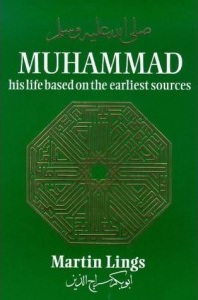Muhammad: His Life Based on the Earliest Sources
 The cover of the 1991 edition | |
| Author | Martin Lings |
|---|---|
| Country | United Kingdom |
| Language | English |
| Series | 1st Edition (1983) 2nd Edition (1991) |
| Subject | Biography |
| Genre | Non-fiction |
| Publisher | Islamic Texts Society (1991), Inner Traditions (2006) |
Publication date | 1 January 1983 |
| Media type | |
| Pages | 362 |
| ISBN | 978-0946621330 |
| OCLC | 9195533 |
Muhammad: His Life Based on the Earliest Sources is an award-winning 1983 biography of the Islamic Prophet Muhammad by Martin Lings.
Overview
This retelling of the sira or life of the Prophet is based directly on Arabic sources of the eighth and ninth centuries, including some passages which were translated here for the first time. The book has been repeatedly acclaimed as a literary tour de force and as a rare wedding of compelling narrative with impeccable scholarship.[1]
Sources used are Ibn Ishaq (references here are to Ferdinand Wüstenfeld’s edition of Sirat Rasul Allah, a life of the Prophet by Muhammad ibn Ishaq in the annotated recension of Ibn Hisham). Also Ibn Sa’ad (the references are to John Leyden’s edition of Kitab al-Tabaqat al Kabir by Muhammad ibn Sa’d). Also there is Al-Waqidi (and the references are to Marsden Jones’ edition of Kitab al-Maghazi, A Chronicle of the Prophet’s Campaigns, by Muhammad ibn Umar al- Waqidi).[2]
This work has gone through many reprints in English and it has been translated and published into many languages[3] including French, Italian, Spanish, Portuguese, Turkish, Dutch, German, Swedish, Malay and Tamil.
1991 edition
In 1991 a second revised edition of the book with 22 additional pages was published, containing additional details pertaining to Muhammad’s endeavors as well as accounts covering the spread of Islam into Syria and its neighboring states surrounding the Arabian Peninsula.[4]
Critical reception
Hamza Yusuf Hanson hails this work as “one of the great biographies of the English language”, praising “the historical accuracy of the text and the providential care so evident in the author’s choice of versions as well as the underlying structure of the story as he chose to tell it.” He also reports from Dr Lings how while writing this book, “he was overwhelmed with the presence of the Prophet during the entire time and felt a great blessing in having been able to complete it.”[5]
The Spectator described the book as “an enthralling story that combines impeccable scholarship with a rare sense of the sacred worthy of his subject.” The Islamic Quarterly called the book “...a true work of art, as enthralling as the best novels with the difference that this is not fiction but fact.”[6]
The Times said “this work is widely recognized as the most readable account of the life of the Prophet to date.”[4] Parabola stated that “for those interested in Islam in one way or another, it is mesmerizing.”[7]
Upon its first edition, the book was subject to criticism by some Muslims who decried the “Perennialist poison” in the book. The author gave public answer in a Saudi newspaper to the objections.[8]
Awards
In 1983, the book was selected as the best biography of the Prophet in English at the National Seerat Conference in Islamabad. This book was also given an award by the government of Pakistan.[9]
In 1990, after the book had attracted the attention of Azhar University, Lings received a decoration from President Hosni Mubarak.[9]
See also
References
- ^ Review by Dr Asma Afsaruddin, Indiana University. Quoted by Reza Shah-Kazemi in “A Truly Holy Soul”, Q-News no. 363, June 2005.
- ^ "Muhammad: His Life Based on the Earliest Sources". Fons Vitae. Retrieved 1 July 2013.
- ^ Records at WorldCat bibliographical database and at Google books.
- ^ a b "Muhammad : His Life Based on the Earliest Sources : Revised Edition : Martin Lings (Abu Bakr Siraj Ad-Din)". Islamic Bookstore.com. Retrieved 1 July 2013.
- ^ “A Spiritual Giant”, Q-News no. 363, June 2005.
- ^ "Muhammad: His Life Based on the Earliest Sources". Amazon.co.uk. 1 January 1983. Retrieved 1 July 2013.
- ^ "Muhammad: His Life Based on the Earliest Sources". Amazon.com. 6 October 2006. Retrieved 1 July 2013.
- ^ Correspondence between a critic and Dr Lings.
- ^ a b Book description at Islamic Texts Society.
